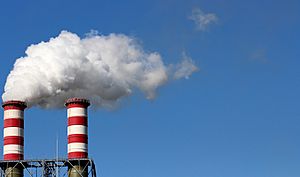Externality facts for kids
In economics, sometimes decisions made by one person or group can affect others who weren't part of that decision. These effects can be good or bad, and they happen without anyone paying for them or being asked. This is called an externality, or an external effect. The main problem with externalities is that the costs or benefits aren't included in the original decision. This often means the market isn't working perfectly, which economists call a market failure. Governments or other groups often need to step in to help.
For example, pollution is a common externality. When a factory pollutes the air, people living nearby might get sick, even if they don't buy anything from that factory. They suffer the bad effect (pollution) without being paid for it.
Contents
What is an Externality?
An externality happens when an action by one person or company has a side effect on someone else. This side effect is not planned or paid for. It's like a ripple effect from a stone thrown into a pond.
Good and Bad Side Effects
Externalities can be either good or bad.
- Negative externalities are when the side effect is harmful.
- Positive externalities are when the side effect is helpful.
Negative Externalities: The Bad Stuff
A classic example of a negative externality is pollution. When a factory makes products, it might also release smoke or waste into the air or water. This pollution harms the environment and the health of people living nearby. The factory doesn't pay for this harm, and the affected people don't get paid for suffering it.
Another example is noise pollution. If a loud concert is held in a park, nearby residents might be disturbed by the noise. They didn't choose to be part of the concert, but they are negatively affected.
Positive Externalities: The Good Stuff
Sometimes, an action can have good side effects for others. This is a positive externality. For example, if your neighbor plants a beautiful garden, you get to enjoy looking at it too. You didn't pay for the garden, but you benefit from it.
Another example is getting a vaccine. When you get vaccinated, you protect yourself from a disease. But you also help protect others by making it harder for the disease to spread. This makes the whole community safer.
Why are Externalities a Problem?
Externalities are a problem because they lead to unfair situations. When there's a negative externality, the people causing the problem don't pay the full cost of their actions. This means they might do too much of the harmful activity. For example, a factory might pollute more if it doesn't have to pay for the cleanup or health problems it causes.
When there's a positive externality, the people creating the good effect don't get paid for all the benefits they create. This means they might do too little of the helpful activity. For instance, if planting a garden only benefits your neighbor, you might not plant as many flowers as you would if you were paid for the joy it brings them.
How Can We Fix Externalities?
Because externalities cause problems, governments and other groups often try to fix them. The goal is to make sure that the true costs and benefits of actions are considered.
Making Polluters Pay: Taxes
One way to deal with negative externalities like pollution is to introduce taxes. For example, a government might put a tax on carbon dioxide emissions. Carbon dioxide is a gas that causes global warming. By taxing it, companies have to pay for the pollution they create. This makes them want to pollute less, because it costs them money. The money collected from these taxes can also be used to clean up pollution or help those affected.
Trading Pollution Rights: Emissions Trading
Another way to manage pollution is through something called emissions trading. Imagine a government sets a limit on how much pollution can be released in total. Then, it gives out "permits" that allow companies to pollute a certain amount. Companies can then buy and sell these permits from each other. If a company pollutes less, it can sell its extra permits to a company that needs to pollute more. This creates a financial reason for companies to reduce their pollution. It makes the cost of pollution part of the market system.
Images for kids
-
Air pollution from motor vehicles is an example of a negative externality. The costs of the air pollution for the rest of society is not compensated for by either the producers or users of motorized transport.
-
Light pollution is an example of an externality because the consumption of street lighting has an effect on bystanders that is not compensated for by the consumers of the lighting.
See also
 In Spanish: Externalidad para niños
In Spanish: Externalidad para niños









